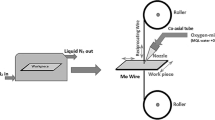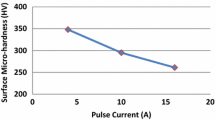Abstract
High-speed wire electrical discharge machining (HS-WEDM) using hard water working liquid results in the machined surface losing metallic luster and reducing the cutting speed comparing with distilled water working fluid. Scanning electron microscopy (SEM) was used to observe the microscopic surface of the workpiece. The chemical composition of the machined surface was analyzed via energy-dispersive X-ray spectroscopy (EDS). Results indicated that the primary cause for lost metallic luster of the machine’s surface was the Cl− present in hard water, which was easily adsorbed on the surface of the workpiece under high-temperature and pressure inter-electrode conditions, resulting in pitting corrosion. By analyzing the conductivity and the continuous discharge waveforms of distilled water and hard water working liquid, it was determined that the reduced cutting speed was because the hard water working liquid contained ions such as Ca2+ and Mg2+, which were adsorbed by the colloid in the working fluid. This resulted in the loss of dielectric property for the working fluid. Furthermore, the conductivity of hard water working fluid is higher, making it easier to be broken down under the same voltage, which results in a larger discharge gap and reduced cutting speed. A method of distilling the hard water to remove the ions was presented to circumvent this; after which, the cutting surface recovered metallic luster and the general machining speed increased.











Similar content being viewed by others
References
Patil PA, Waghmare CA (2014) A review on advances in wire electrical discharge machining. In: Khangura S, Singh P, Singh H, Brar G (eds) Proceedings of the international conference on research and innovations in mechanical engineering. Lecture Notes in Mechanical Engineering. Springer, New Delhi
Maher I, Sarhan AAD, Hamdi M (2015) Review of improvements in wire electrode properties for longer working time and utilization in wire EDM machining. Int J Adv Manuf Technol 76:329. https://doi.org/10.1007/s00170-014-6243-3
Haas P, Pontelandolfo P, Perez R (2013) Particle hydrodynamics of the electrical discharge machining process. Part 1: physical considerations and wire EDM process improvement. The seventeenth CIRP conference on electro physical and chemical machining (ISEM). Procedia CIRP 6:47–52
Wang ZY (1987) Wire electrical discharge machining process. Atomic Energy Press, Bei**g
Lu LY, Liu ZD, Tian ZJ, Wei W (2011) Research on cooling liquid failure of WEDM-HS. China Mech Eng 15:1793–1797
Zhang YQ, Liu ZD, Pan H, Qiu MB (2017) Dielectric fluid lifespan detection based on pulse discharge probability in wire electrical discharge machining [J]. Int J Adv Manuf Technol 92(6):1–11
Pan H, Liu Z, Li CR, Zhang YQ, Qiu MB (2017) Enhanced debris expelling in high-speed wire electrical discharge machining [J]. Int J Adv Manuf Technol 93(5–8):1–8
Zhang Z, Huang H, Ming WY, Xu Z, Huang Y, Zhang GJ (2016) Study on machining characteristics of WEDM with ultrasonic vibration and magnetic field assisted techniques. J Mater Process Technol 234:342–352
Wang J, Han FZ (2014) Simulation model of debris and bubble movement in consecutive-pulse discharge of electrical discharge machining. Int J Adv Manuf Technol 74:591–598. https://doi.org/10.1007/s00170-014-6008-z
Li MH (1989) Theoretical foundation of electrical discharge machining [M]. National Defense of Industry Press, Bei**g
Zhang Y, Liu Z, **a L, Wang W (2016) Inter-electrode discharge mechanism in high-speed wire electrical discharge machining [J]. Int J Adv Manuf Technol 84(9–12):2637–2647
Acknowledgments
We extend our sincere thanks to all who contributed in the preparation of these instructions.
Funding
This project was financially supported by the National Natural Science Foundation of China (Grant Nos. 51575271 and 51675272).
Author information
Authors and Affiliations
Corresponding author
Additional information
Publisher’s note
Springer Nature remains neutral with regard to jurisdictional claims in published maps and institutional affiliations.
Rights and permissions
About this article
Cite this article
Zhang, Y., Liu, Z., Zhang, M. et al. Study on the influence that hard water had in high-speed wire electrical discharge machining. Int J Adv Manuf Technol 104, 1251–1258 (2019). https://doi.org/10.1007/s00170-019-04043-z
Received:
Accepted:
Published:
Issue Date:
DOI: https://doi.org/10.1007/s00170-019-04043-z




